The Sarasota Ballet presents an all-Ashton program at the Joyce Theater.
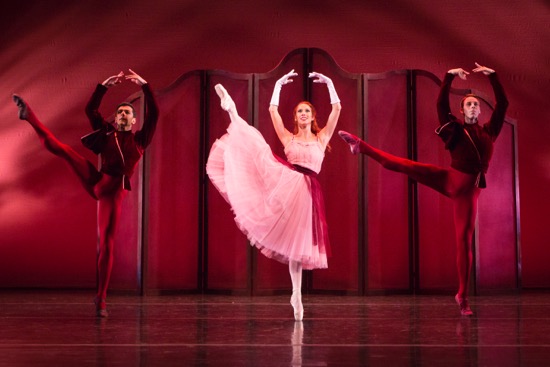
One cast in the Sarasota Ballet’s production of Frederick Ashton’s Valses Nobles et Sentimentales. (L to R): Ricardo Graziano, Danielle Brown, and Jamie Carter. Photo: Yi-Chun Wu
I have long been enamored of Frederick Aston’s ballets—narrative ones, such as La Fille mal gardée, Cinderella, and The Dream; abstract ones, such as Monotones; and thoroughly unusual ones, such as A Wedding Bouquet and Enigma Variations. There’s something sweet-tempered about all of them. Who but Ashton would make one of Cinderella’s stepsisters shy and uncertain about how far into evilness she was prepared to go? Who but he would unite Oberon and Titania in a final pas deux so rapturously sensual that you could imagine a flotilla of fairy offspring resulting from it?
Often, there’s something surprising or unusual about this British choreographer’s ballets, a fact made very clear by the all-Ashton program that the Sarasota Ballet presented at the Joyce Theater the second week of August. That program, put together by the company’s director, Iain Webb, and its assistant director Margaret Barbieri (both once dancers in England’s Royal Ballet and with impressive subsequent resumes), is in itself surprising: Ashton’s witty little vaudeville Façade (1931), a charming work from 1947 (Valses Nobles et Sentimentales), the second movement from Sinfonietta (1967), a duet from Jazz Calendar (1968), and two that began life as pieces d’occasion: The Walk to the Paradise Garden (1972) and Tweedledum and Tweedledee (1977).
The program opens with Valses Noble et Sentimentales, set to Maurice Ravel’s bittersweet music of the same name. Four couples waltz at what could be a debutante ball, with gloved gentlemen and fluffy-skirted young ladies with bows in their hair, plus one more couple (Victoria Hulland and Ricardo Rhodes in the cast that I saw). As always, Ashton’s choreography makes you aware of the dancers’ feet—not only because they do small, tricky things and twitter with excitement, but because the performers often look at them, as if encouraging them or pointing them out. Members of the Sarasota Ballet also display a freedom in their upper bodies that eloquently conveys the abandon invading a ballroom as the night wears on.
Partners change, couples leave and return. In one encounter, Rhodes and Edward Gonzalez cooperate in making Hulland feel like a queen. She maintains a balance on one toe-tip, with her other leg stuck out to the side, and they slowly rotate her, exchanging places as they do so. In a later scene, one of the two men holds both Hulland’s hands in his, while the other turns her; the resulting moving sculpture is too deliciously and fluidly complex to describe. But there’s something curious about this rose-tinged ballroom. The original designer, Sophie Fedorovitch, placed a rococo, three-panel, free-standing screen at the rear center of the stage, and a slightly smaller one on either side. These are translucent, and sometimes clearly represent mirrors, with one dancer behind and another in front, touching each other in the expected symmetry. At other times, the area behind the screens seems just a glimpse of another room, or a dream of happiness. In the end, as the curtain falls, Hulland is behind the central screen, being lifted over and over; she seems to leap into the air, made buoyant by love and dancing.
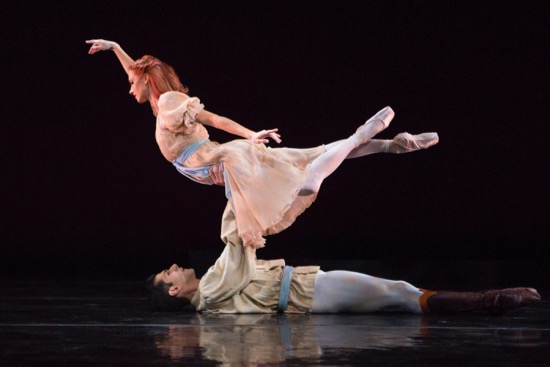
Danielle Brown and Ricardo Graziano in one cast of The Walk to the Paradise Garden. Photo: Yi-Chun Wu
The Walk to the Paradise Garden is also about happiness between partners, but it has a darker side and a strange ending. Ashton drew the music for this pas de deux from Frederick Delius’s opera A Village Romeo and Juliet, and the choreography evokes the wedding night that Shakespeare implied but did not linger on. Or perhaps Ashton was drawing out that dawn scene in which Juliet begs Romeo to stay a little longer.
The lovers (I saw Rhodes and Ryoko Sadoshima) treat the floor as if it were their bed; he supine, but with one arm wrapped around the woman who sits nestled against him. They often return to the floor—she lying on him and arching ecstatically back, he pushing her up to fly above him. They twine and kiss. She rushes away and then returns to be lifted high. When he picks her up to swing her from side to side, her feet quiver.
Sadoshima is lovely in this—dewy fresh and youthful in her eagerness, and Rhodes is an ardent partner. However, they are not truly alone. Anyone reading the program in advance will have noticed the name of a third cast member; I, who hadn’t done so, was startled to see another man walk across the back of the stage and onto the discreet and unused platform I had been wondering about (I suspect that this moment may appear differently in another theater—that is, that he could be “discovered” in place on the platform). The man (Jacob Hughes) is bald and dressed only in a white diaper of sorts with a trailing blue cape over his arms. Sadoshima and Rhodes, holding each other close, move toward him and are folded into his embrace. In the end, both are behind this grave, adament figure, reaching around him toward each one’s now unobtainable lover. He is, of course, Death.

(L to R): Alex Harrison, Samantha Benoit, and Logan Learned in Frederick Ashton’s Tweedledum and Tweedledee. Photo: Yi-Chun Wu
The Walk to the Paradise Garden was preceded at the Joyce by a cheerier, more bumptious trio, in which Lewis Carroll’s twins (the well-padded Sam O’Brien and Kyle Hyoshi) astonish Alice (Elizabeth Sykes) as she navigates Wonderland. The three show off their footwork on stools, the two men indulge in a hornpipe and pull on imaginary ropes, they bump chests, and Alice hops on pointe. And a good time is had by all.
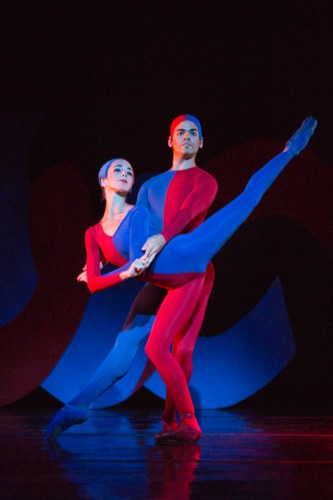
Ellen Overstreet and Edward Gonzalez in one cast of Sarasota Ballet’s production of “Friday’s Child” from Ashton’s Jazz Calendar. Photo: Yi-Chun Wu
I wasn’t crazy about Jazz Calendar when I saw it years ago; set to a score by Richard Rodney Bennett, its approach to jazz seemed to me too cute, too polite. But the excerpt shown on this program struck me as another example of Ashton’s unusual view of his subject matter. Amy Wood and Edward Gonzalez wear caps and unitards split vertically between red and blue—costumes that downplay their gender. The ballet is divided into sections defined by the rhyme that begins, “Monday’s child is fair of face,” and this duet exemplifies, “Friday’s child is loving and giving.” But Ashton evades a depiction of giver and receiver; for the most part, the two performers tangle together in ingenious ways that–with the help of the costumes—may make you wonder briefly which leg is whose. The music is bluesy and the movements smooth, but you’re hardly surprised that, despite the lifts, the two dancers end up on the floor, tied into a knot.
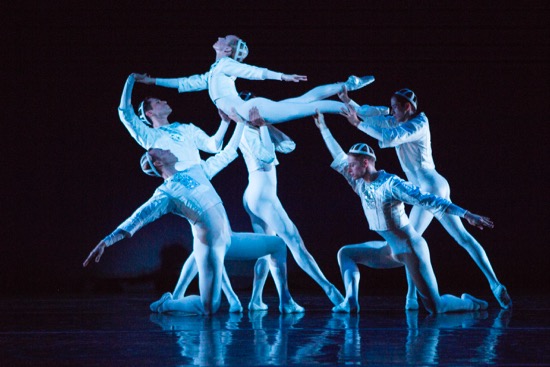
The second movement of Frederick Ashton’s Sinfonietta: Victoria Hulland lifted by (in no particular order) Ricardo Rhodes, David Tlaiye, Jamie Carter, Daniel Rodriguez, and Daniel Pratt. Photo: Yi-Chun Wu
The second movement of Sinfonietta (music by Sir Malcom Williamson) reminded me of the second trio in the choreographer’s Monotones, in which two white-clad, white-capped men manipulate a gracious, identically dressed woman. In the Sinfonietta excerpt, a woman (Ellen Overstreet in the cast I saw) is attended by five men—all in white unitards, with one of them (Ricardo Graziano) as a sometime leader). They seem committed to not letting her feet touch the ground. She is their queen, but also their plaything. She sits on Graziano, and the others collaborate to revolve the two of them. She is swung into a back flip and ends up hovering over them in a swan dive. One move is almost miraculous in its complexity; held up by the four men, she grasps both Graziano’s hands in hers, and somehow the whole sculptural image turns inside out.
In the most amazing (and disturbing) maneuver, Overstreet raises one leg to the side, and Graziano lifts her high by grasping her other leg as if it were a column; she maintains that position—moving not a hair— while she is revolved and passed to another of the men and then down the waiting line until every one of the four has had a turn. I think of Aurora in The Sleeping Beauty, being appraised and tested by four suitors. This is a far more athletic and accommodating princess, and you fear for her. Perhaps the lovely ordeal was too much for them too; like puppets whose strings have been cut, all six finish in a heap (an orderly one, but still. . . )
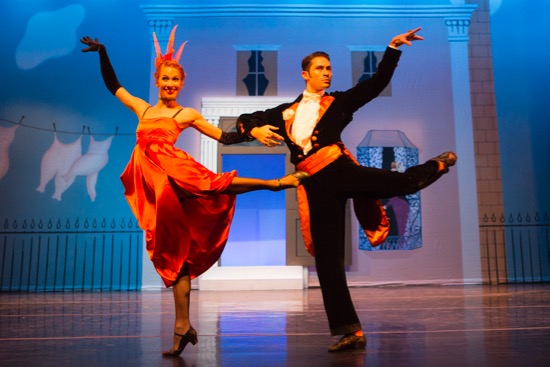
The “Tango-Pasodoble:” Danielle Brown and David Tlaiye in one Sarasota Ballet cast of Ashton’s Facade. Photo: Yi-Chun Wu
The music for Facade was written by its composer, William Walton, to accompany a different sort of event. Each section was accompanied by Edith Sitwell (behind a screen), reciting her poems, her haughty, melodious voice in rhythm with the music Walton had devised to suit each one. (You can hear Sitwell and Peter Pears performing with the score at https://www.youtube.com/watch?v=j5AlUOJs2dI.) John Armstrong’s charming backdrop of a city street includes a door through which most of the performers of the various “acts” emerge, as if they’ve been visiting that house and the painted lady who’s seen in the window and perhaps owns the undergarments hanging on its clothesline.
They’re certainly not all denizens of the neighborhood. Sadoshima, Rachel Costin, and Alex Harrison wear kilts and do jaunty footwork (more chest bumps for the men). The “Swiss Yodeling Song” brings on a milkmaid (Samantha Benoit) with perky, wired-up pigtails and a milking stool; the three men (Patrick Ward, Jamie Carter, and Wilson Livingston) who attend her and rotate her on her stool are happy (or one of them is) to provide her with spread fingers to milk. One of these Alpine mountaineers, in assisting her, is moved to kiss the foot she has raised in the air, and Ashton was not above having him indicate that it smells bad (a milkmaid doesn’t tread on fine carpets, you know). Nicole Padilla shimmies out of her dress to dance the “Polka” in her pretty underwear. The “Foxtrot,” which was added to the ballet in the 1940, features two flappers (Ellen Overstreet and Sykes) enjoying the company of two with-it college boys (Rodriguez and Daniel Pratt), one of whom wears spectacles.
Clearly Ashton wasn’t thinking about homogeneity. Façade is more like a well-bred, but slyly mischievous music hall revue. However, the four young ladies in pretty dresses, waltzing and forming nice patterns while holding hands stay around to watch O’Brien and Hiyoshi—dapper in boaters and striped jackets—perform a little soft-shoe number. And after Hulland and Gonzalez appear properly tempestuous in “Tango-Pasodoble,” the entire cast pairs up for a finale. (In Façade’s 1931 debut at London’s Camargo Society, the Latin duet was performed by Ashton himself and Lydia Lopokova, and you can see the Royal Ballet’s Anthony Dowell and Merle Park perform it here: https://www.youtube.com/watch?v=Fpxk54O1kOI.)
Hulland and Gonzalez do a fine job with this encounter between a lady with feathers in her hair and a suave man, who’s surely a gigolo, with the rings on his fingers catching the light as he strokes her back and whips her in different directions with dizzying precision. In fact, all the Sarasota dancers capture the spirit of these Ashton ballets with splendid spirit. Those who staged the works—primarily Barbieri, but also Lynn Wallis (Sinfonietta) and Webb, who collaborated on Valses Nobles et Sentimentales—have coached them wisely and sensitively. Who could have imagined that twenty-three ballets by this marvelous British choreographer would flourish in Florida, among the many other works in Sarasota Ballet’s repertory? Although, come to think of it, Sir Frederick Ashton (1904-1988) was born in Ecuador of English parents and spent his childhood there and in Peru. He’d have felt quite at home on the Gulf Coast.

Very much enjoyed this account of Sarasota. They are a good company for the most part, and they do Ashton well. Webb & Barbieri have trained them esp well in upper body & port de bras. They have a number of beautiful dancers, esp Victoria Hulland, Amy Wood, Danielle Browne, & Ellen Overstreet, who can suggest interiority as well as the presentational style the company is best at. I’ve seen performances of Monotones with both Hulland & Wood in Monotones II, & both were exceptional. When casting puts more presentational ballerinas into ballets that demand greater subtlety, however, the company can look very wrong, as at the performance of Balanchine’s Emeralds I saw early this year, and Sarasota also has very few capable men, making partnering an occasional problem & solo variations occasionally embarrassing. I’m very glad you saw only the middle movement of Sinfonietta: it’s brilliantly mysterious, even if it owes something to Balanchine’s Unanswered Question, and it works on its own–the 1st & 3rd movements look overly jolly & trivial by comparison, creating tonal problems. In any event, it’s wonderful that Sarasota is bringing back so much Ashton, keeping the less-known one-acts alive while ABT is tackling his blockbusters. One last thing: I’ve also seen Sarasota do Ashton’s Illuminations, originally made for NYCB in 1951, and you can see how he made roles designed for a Balanchine company (with Tanaquil LeClercq cast a bit against type as Sacred Love, while Missy Hayden was Profane Love). It’s an often silly, point-for-point allegorical ballet, but it’s wholly absorbing with lots of strong choreography, & I wish NYCB would revive it.